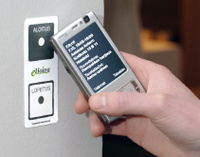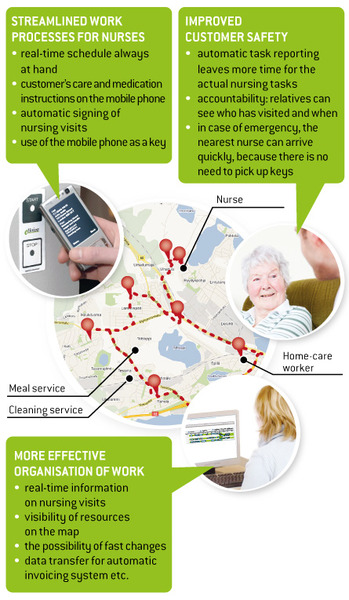e-Hoiva is versatile
• appointments
• treatment plans
• shift planning
• optimisation of nursing visit resources
• details for invoicing
• registration on the spot
eHoiva brings savings
• easier work planning
• real-time resource control
• easies reporting of nursing calls and visits
• improved customer service
eHoiva Palveluverkko
Tel. +358 45 357 2907
info@eHoiva.fi
eHoiva - a cost-effective and versatile solution for control of home-care operations
eHoiva Palveluverkko (eCare Service Network) has made it easy to co-ordinate work throughout the service organisation in an effective and cost-saving manner. It has created a comprehensive system that combines shift planning, monitoring of working hours, real-time management of service resources, and data transfer for invoicing. Furthermore, the system can be connected to electric locking and access control systems, which means that nurses can use their mobile phone as a key to the customer’s home.
eHoiva - real-time management of nursing processes
The service provider can check the location of each nurse in real time. If urgent nursing calls arrive in the middle of the day, the available nurses can be located and summoned very quickly. Nurses see their daily schedule from their mobile phone, which is automatically updated with the day’s completed and upcoming tasks. All nursing visits are registered in detail for invoicing purposes as well.
 Nurses have the real-time nursing visit and task information with them at all times. |
e-Hoiva - relieving the burden of managing keys
At the start of their shift, nurses register a mobile phone by touching it with their ID card. This enables the use of that mobile phone as a key to the customer’s home. The nursing visits and customer data are automatically updated on the screen. During the work day, nurses can make emergency visits without having to collect the customer’s key from the service centre. The location information enables the supervisor to see the location of each nurse, which enables summoning the closest available nurse in an emergency. This means a significant increase in customer safety.
The number of pensioners relative to the working population is continuously increasing, and our nursing resources are under stress. The longer the elderly can live at home, the more meaningful they will find their life. In addition, living longer at home means significant savings in public care resources. The drawback, however, is that those receiving home care are geographically dispersed, which makes the organisation of nursing care quite challenging.

